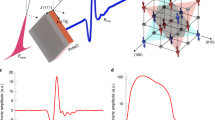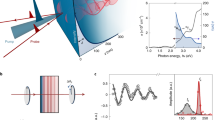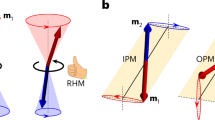Abstract
Antiferromagnets (AFMs) possess great potential in spintronics because of their immunity to external magnetic disturbance, the absence of a stray field or the resonance in the terahertz range1,2. The coupling of insulating AFMs to spin–orbit materials3,4,5,6,7 enables spin transport via AFM magnons. In particular, spin transmission over several micrometres occurs in some AFMs with easy-axis anisotropy8,9. Easy-plane AFMs with two orthogonal, linearly polarized magnon eigenmodes own unique advantages for low-energy control of ultrafast magnetic dynamics2. However, it is commonly conceived that these magnon modes are less likely to transmit spins because of their vanishing angular momentum9,10,11. Here we report experimental evidence that an easy-plane insulating AFM, an α-Fe2O3 thin film, can efficiently transmit spins over micrometre distances. The spin decay length shows an unconventional temperature dependence that cannot be captured considering solely thermal magnon scatterings. We interpret our observations in terms of an interference of two linearly polarized, propagating magnons in analogy to the birefringence effect in optics. Furthermore, our devices can realize a bi-stable spin-current switch with a 100% on/off ratio under zero remnant magnetic field. These findings provide additional tools for non-volatile, low-field control of spin transport in AFM systems.
This is a preview of subscription content, access via your institution
Access options
Access Nature and 54 other Nature Portfolio journals
Get Nature+, our best-value online-access subscription
$29.99 / 30 days
cancel any time
Subscribe to this journal
Receive 12 print issues and online access
$259.00 per year
only $21.58 per issue
Buy this article
- Purchase on Springer Link
- Instant access to full article PDF
Prices may be subject to local taxes which are calculated during checkout




Similar content being viewed by others
Data availability
The data that support the findings of this study are presented in the main text and the Supplementary Information, and are available from the corresponding author upon reasonable request.
Code availability
The script for modelling spin wave propagation was written in MATLAB (Mathworks). The codes are available from the corresponding author upon reasonable request.
References
Jungwirth, T., Marti, X., Wadley, P. & Wunderlich, J. Antiferromagnetic spintronics. Nat. Nanotechnol. 11, 231–241 (2016).
Baltz, V. et al. Antiferromagnetic spintronics. Rev. Mod. Phys. 90, 015005 (2018).
Wang, H., Du, C., Hammel, P. C. & Yang, F. Antiferromagnonic spin transport from Y3Fe5O12 into NiO. Phys. Rev. Lett. 113, 097202 (2014).
Hahn, C. et al. Conduction of spin currents through insulating antiferromagnetic oxides. Europhys. Lett. 108, 57005 (2014).
Seki, S. et al. Thermal generation of spin current in an antiferromagnet. Phys. Rev. Lett. 115, 266601 (2015).
Wu, S. M. et al. Antiferromagnetic spin seebeck effect. Phys. Rev. Lett. 116, 097204 (2016).
Qiu, Z. et al. Spin colossal magnetoresistance in an antiferromagnetic insulator. Nat. Mater. 17, 577–580 (2018).
Yuan, W. et al. Experimental signatures of spin superfluid ground state in canted antiferromagnet Cr2O3 via nonlocal spin transport. Sci. Adv. 4, eaat1098 (2018).
Lebrun, R. et al. Tunable long-distance spin transport in a crystalline antiferromagnetic iron oxide. Nature 561, 222–225 (2018).
Gomonay, O., Baltz, V., Brataas, A. & Tserkovnyak, Y. Antiferromagnetic spin textures and dynamics. Nat. Phys. 14, 213–216 (2018).
Keffer, F. & Kittle, C. Theory of antiferromagnetic resonance. Phys. Rev. 85, 329–337 (1952).
Cornelissen, L. J., Liu, J., Duine, R. A., Youssef, J. B. & van Wees, B. J. Long-distance transport of magnon spin information in a magnetic insulator at room temperature. Nat. Phys. 11, 1022–1026 (2015).
Williamson, S. J. & Foner, S. Antiferromagnetic resonance in systems with Dzyaloshinsky-Moriya coupling; orientation dependence in α-Fe2O3. Phys. Rev. 136, A1102–A1106 (1964).
Khymyn, R., Lisenkov, I., Tiberkevich, V. S., Slavin, A. N. & Ivanov, B. A. Transmission of spin current by antiferromagnetic insulators. Phys. Rev. B 93, 224421 (2016).
Rezende, S. M., Rodríguez-Suárez, R. L. & Azevedo, A. Diffusive magnonic spin transport in antiferromagnetic insulators. Phys. Rev. B 93, 054412 (2016).
Chen, X. Z. et al. Antidamping-torque-induced switching in biaxial antiferromagnetic insulators. Phys. Rev. Lett. 120, 207204 (2018).
Baldrati, L. et al. Mechanism of Néel order switching in antiferromagnetic thin films revealed by magnetotransport and direct imaging. Phys. Rev. Lett. 123, 177201 (2019).
Cheng, Y., Yu, S., Zhu, M., Hwang, J. & Yang, F. Electrical switching of tristate antiferromagnetic Néel order in α-Fe2O3 epitaxial films. Phys. Rev. Lett. 124, 027202 (2020).
Sulymenko, O. R. et al. Terahertz-frequency spin Hall auto-oscillator based on a canted antiferromagnet. Phys. Rev. Appl. 8, 064007 (2017).
Shimomura, N. et al. Morin transition temperature in (0001)-oriented α-Fe2O3 thin film and effect of Ir doping. J. Appl. Phys. 117, 17C736 (2015).
Fujii, T., Takano, M., Kakano, R., Isozumi, Y. & Bando, Y. Spin-flip anomalies in epitaxial α-Fe2O3 films by Mössbauer spectroscopy. J. Magn. Magn. Mater. 135, 231–236 (1994).
Gota, S., Gautier-Soyer, M. & Sacchi, M. Magnetic properties of Fe2O3(0001) thin layers studied by soft X-ray linear dichroism. Phys. Rev. B 64, 224407 (2001).
Wesenberg, D., Liu, T., Balzar, D., Wu, D. & Zink, B. L. Long-distance spin transport in a disordered magnetic insulator. Nat. Phys. 13, 987–993 (2017).
Cheng, R., Xiao, J., Niu, Q. & Brataas, A. Spin pumping and spin-transfer torques in antiferromagnets. Phys. Rev. Lett. 113, 057601 (2014).
Giles, B. L., Yang, Z., Jamison, J. S. & Myers, R. C. Long-range pure magnon spin diffusion observed in a nonlocal spin-Seebeck geometry. Phys. Rev. B 92, 224415 (2015).
Guo, E.-J. et al. Influence of thickness and interface on the low-temperature enhancement of the spin Seebeck effect in YIG films. Phys. Rev. X 6, 031012 (2016).
Zhou, X. J. et al. Lateral transport properties of thermally excited magnons in yttrium iron garnet films. Appl. Phys. Lett. 110, 062407 (2017).
Cornelissen, L. J., Shan, J. & van Wees, B. J. Temperature dependence of the magnon spin diffusion length and magnon spin conductivity in the magnetic insulator yttrium iron garnet. Phys. Rev. B 94, 180402(R) (2016).
Searle, C. W. & Dean, G. W. Temperature and field dependence of the weak ferromagnetic moment of hematite. Phys. Rev. B 1, 4337–4342 (1970).
Kamra, A., Agrawal, U. & Belzig, W. Noninteger-spin magnonic excitations in untextured magnets. Phys. Rev. B 96, 020411(R) (2017).
Alikhanov, R. A. et al. Investigation of magnon dispersion relation in α-Fe2O3 – additional data. Phys. Stat. Sol. 41, K103–K106 (1970).
Cheng, R., Daniels, M. W., Zhu, J.-G. & Xiao, D. Antiferromagnetic spin wave field effect transistor. Sci. Rep. 6, 24223 (2016).
Bender, S. A. & Tserkovnyak, Y. Interfacial spin and heat transfer between metals and magnetic insulators. Phys. Rev. B 91, 140402(R) (2015).
Bayrakci, S. P., Keller, T., Habicht, K. & Keimer, B. Spin-wave lifetimes throughout the Brillouin zone. Science 312, 1926–1929 (2006).
Chmiel, F. P. et al. Observation of magnetic vortex pairs at room temperature in a planar α-Fe2O3/Co heterostructure. Nat. Mater. 17, 581–585 (2018).
Ross, A. et al. Propagation length of magnons governed by domain configurations. Nano Lett. 20, 306–313 (2019).
Olejník, K. et al. Terahertz electrical writing speed in an antiferromagnetic memory. Sci. Adv. 4, eaar3566 (2018).
Chiang, C. C., Huang, S. Y., Qu, D., Wu, P. H. & Chien, C. L. Absence of evidence of electrical switching of the antiferromagnetic Néel vector. Phys. Rev. Lett. 123, 227203 (2019).
Acknowledgements
This work is supported in part by National Science Foundation under award no. ECCS-1808826, AFOSR, and by SMART, one of seven centres of nCORE, a Semiconductor Research Corporation programme, sponsored by National Institutes of Standards and Technology (NIST). The material synthesis and characterization are partially supported by the National Science Foundation under award no. DMR 14-19807 through the MRSEC shared facilities. J.H. thanks Y. Lin, P.-C. Shih and A.-Y. Lu for help with measurements.
Author information
Authors and Affiliations
Contributions
J.H. fabricated the devices and performed the electrical measurements with technical support from Y.F., T.S.S. and J.X. P.Z. prepared the α-Fe2O3 thin-film samples. P.Z. and J.F. characterized the samples. R.C., L.L, Z.B., L.F. and J.H. performed theoretical analysis. All authors commented on the manuscript.
Corresponding author
Ethics declarations
Competing interests
The authors declare no competing interests.
Additional information
Peer review information Nature Nanotechnology thanks Jun’ichi Ieda and the other, anonymous, reviewer(s) for their contribution to the peer review of this work.
Publisher’s note Springer Nature remains neutral with regard to jurisdictional claims in published maps and institutional affiliations.
Supplementary information
Supplementary Information
Supplementary texts and Figs. 1–13.
Rights and permissions
About this article
Cite this article
Han, J., Zhang, P., Bi, Z. et al. Birefringence-like spin transport via linearly polarized antiferromagnetic magnons. Nat. Nanotechnol. 15, 563–568 (2020). https://doi.org/10.1038/s41565-020-0703-8
Received:
Accepted:
Published:
Issue Date:
DOI: https://doi.org/10.1038/s41565-020-0703-8
This article is cited by
-
Reconfigurable spin current transmission and magnon–magnon coupling in hybrid ferrimagnetic insulators
Nature Communications (2024)
-
Dipolar spin wave packet transport in a van der Waals antiferromagnet
Nature Physics (2024)
-
Manipulating chiral spin transport with ferroelectric polarization
Nature Materials (2024)
-
Long-range, non-local switching of spin textures in a frustrated antiferromagnet
Nature Communications (2023)
-
Coherent antiferromagnetic spintronics
Nature Materials (2023)



